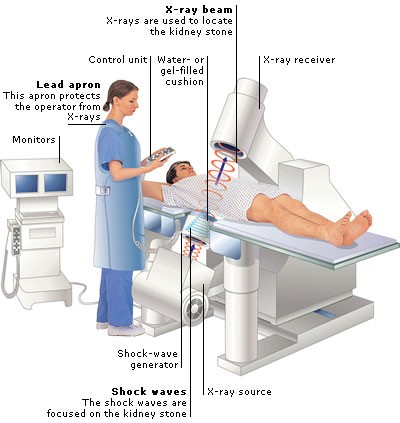ESWL therapy for kidney stones
ESWL therapy for kidney stones
ESWL, or extracorporeal shockwave lithotripsy, is a non-invasive method for treating stones in the kidney or ureter, by utilizing an energy source which generates a shock wave that is directed at the stone. The shock wave is focused to the stone by either an X-ray unit or ultrasound.
You may be given some pain killers or sedation before the procedure. You will be awake during the procedure which will last approximately 1-1 ½ hours.
The purpose of the ESWL therapy is to break the stones non-invasively (i.e. it is not an operation; the procedure is done without any incision or cutting).
There are very specific indications where ESWL therapy may be done, and you can discuss this with your doctor.
Extracorporeal shock wave lithotripsy (ESWL) uses shock waves to break a kidney stone into small pieces that can more easily travel through the urinary tract and pass from the body.

The ESWL machine

The ESWL procedure of blasting the stone with shock waves (Pic from Urology Asssociates)
Procedure
- You lie on a water-filled cushion, and the surgeon uses X-rays or ultrasound tests to precisely locate the stone. High-energy sound waves pass through your body without injuring it and break the stone into small pieces. These small pieces move through the urinary tract and out of the body more easily than a large stone.
- The process takes about an hour.
- You may receive sedation or local anesthesia.
- Your surgeon may insert a ureteric stent if you have a large stone. A stent is a small, short tube of flexible plastic mesh that holds the ureter open. This helps the small stone pieces to pass without blocking the ureter.

The ESWL procedure of blasting the stone with shock waves
Why It Is Done
ESWL may be used on a person who has a kidney stone that is causing pain or blocking the urine flow. Stones that are between 4 mm and 2 cm in diameter are most likely to be treated with ESWL.
ESWL may work best for kidney stones in the kidney or in the part of the ureter close to the kidney. Your surgeon may try to push the stone back into the kidney with a small instrument (ureteroscope) and then use ESWL.
Risks
Complications of ESWL include:
- Pain caused by the passage of stone fragments.
- Blocked urine flow as a result of stone fragments becoming stuck in the urinary tract. The fragments may then need to be removed with a ureteroscope.
- Urinary tract infection.
- Bleeding around the outside of the kidney.
ESWL is a safe procedure and may be used on children and on individuals with only one functioning kidney.
Informative links
– A review of various urinary stones, how stone forms, the endemic stone belt, and the various treatment for urinary stones – PCNL, ESWL therapy, Retrograde Ureterorenoscopy and RIRS, Antegrade Ureteroscopy
https://www.youtube.com/watch?v=_rfVGKd1ur4
Other links:
https://www.youtube.com/watch?v=0hKRYVrlfdI

